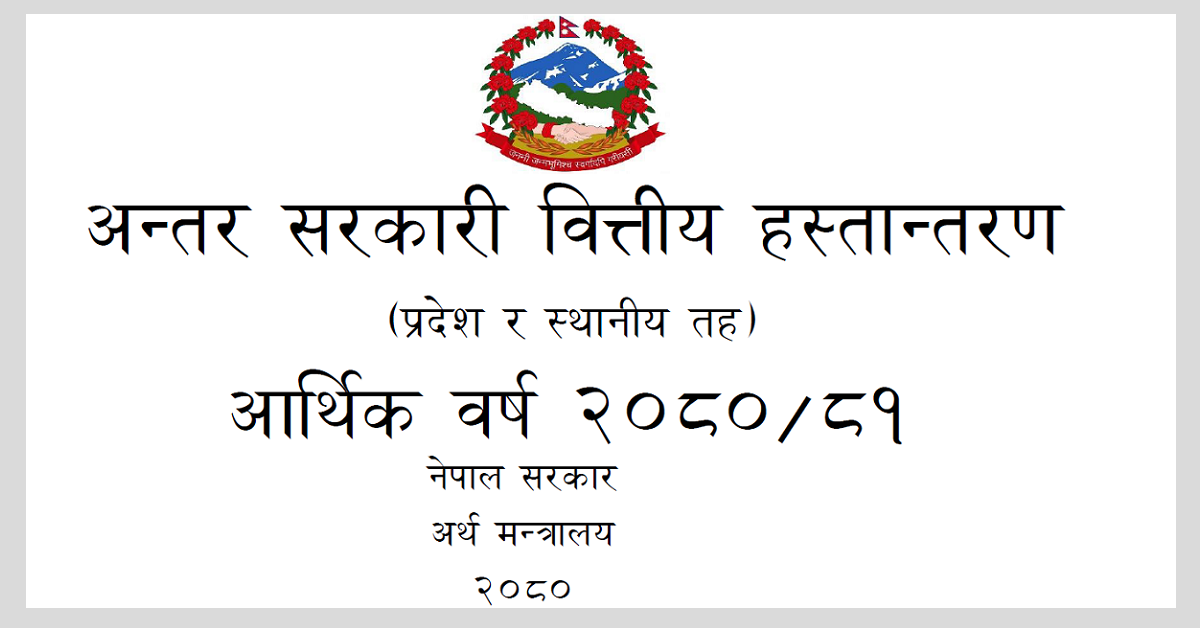
Intergovernmental Fiscal Transfer in Nepal 2080-81:- Intergovernmental Fiscal Transfer (Province and Local Level) in Nepal
Intergovernmental fiscal transfer refers to the exchange of funds between different levels of government within a country. In Nepal, the Ministry of Finance oversees the intergovernmental fiscal transfer for the financial year 2080/81, facilitating the distribution of financial resources among provinces and local governments. This system plays a crucial role in promoting financial federalism and ensuring effective governance.
Key Statistics
- Nepal consists of 7 provinces, each with its own level of government.
- There are a total of 753 local-level governments in Nepal.
- Metropolitan cities in Nepal number 6, while there are 11 sub-metropolitan cities.
- The country has 276 municipalities and 460 rural municipalities.
- Nepal comprises 77 districts, forming the administrative units for governance.
Role of Intergovernmental Fiscal Transfer in Fiscal Federalism
Intergovernmental fiscal transfer serves as one of the pillars of fiscal federalism in Nepal. Its role in strengthening financial federalism can be summarized as follows:
-
Managing Financial Resources: The transfer enables local governments to access the necessary financial resources for implementing their rights and fulfilling their responsibilities.
-
Promoting Cooperation and Coordination: It fosters an environment of cooperation, coexistence, and coordination between the federal, provincial, and local levels of government, ensuring effective governance and service delivery.
-
Empowering Sub-Level Governments: Intergovernmental fiscal transfer empowers sub-level governments by providing them with financial autonomy within their jurisdictions, allowing them to exercise their powers independently.
-
Mobilizing Internal Resources: Local governments are encouraged to identify and mobilize internal resources, promoting self-sufficiency and reducing dependence on external sources.
-
Bridging the Gap: The transfer helps bridge the gap between local needs and available resources, ensuring that local governments have the means to meet their obligations effectively.
-
Financing Rastriya Gaurav Projects: It plays a crucial role in providing the necessary financial support for Rastriya Gaurav projects, which are projects under the responsibility of the federal government.
-
Ensuring Equalization Grants: Intergovernmental transfers include equalization grants, which help eliminate regional disparities and promote human rights by ensuring equitable distribution of resources.
-
Reducing Fiscal Imbalance: By addressing fiscal imbalances and fostering proportional development, intergovernmental financial transfers contribute to the overall economic growth and stability of the country.
Arrangements for Intergovernmental Financial Transfers in Nepal
To facilitate intergovernmental financial transfers in Nepal, the country has established constitutional, legal, and institutional arrangements, including:
-
Constitutional Provisions: The Constitution of Nepal (Article 60) stipulates the distribution of financial equalization grants to provincial and local governments based on their expenditure needs and revenue capacity. These grants are recommended by the National Natural Resources and Finance Commission.
-
Federal Reserve Fund: The Government of Nepal has made provisions for the distribution of conditional grants, supplementary grants, or special grants from the Federal Reserve Fund for specific purposes.
-
National Natural Resources and Finance Commission: This constitutional body is responsible for determining and recommending the pattern of financial transfers based on the needs and capacities of the provincial and local levels.
-
Inter-Governmental Finance Management Act: Enacted in 2074, this act provides detailed interpretation and implementation guidelines for the constitutional provisions related to intergovernmental financial transfers.
-
National Natural Resources and Finance Commission Act: This act further supports the functioning of the National Natural Resources and Finance Commission, ensuring its effective operation.
-
Supplementary and Special Grants Procedures: These procedures outline the process for granting supplementary and special funds to address specific needs and priorities.
-
Inter-Governmental Finance Council: Under the coordination of the Minister of Finance, this council includes representatives from the state and local levels to promote coordination and collaboration.
-
Provincial Coordinating Committee: Headed by the Chief Minister and comprising local level representatives, this committee facilitates cooperation and coordination between the provincial and local governments.
Through these arrangements, Nepal ensures the smooth operation and implementation of intergovernmental financial transfers, enhancing the effectiveness of financial federalism.
Intergovernmental financial transfers play a vital role in promoting financial federalism in Nepal. By providing financial resources and fostering cooperation and coordination among different levels of government, these transfers contribute to the overall development and equitable distribution of resources. With constitutional, legal, and institutional arrangements in place, Nepal is committed to effectively managing intergovernmental financial transfers and ensuring the sustainable and coordinated implementation of financial federalism.
Download or View.PDF (यहाà¤à¤¬à¤¾à¤ डाà¤à¤¨à¤²à¤¾à¥à¤¡ à¤à¤°à¥à¤¨à¥à¤¹à¤¾à¥à¤¸)![]()





